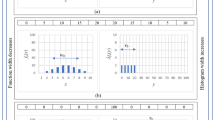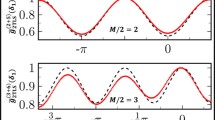Abstract
The problem of detecting a completely known coherent optical signal in a thermal background radiation is considered. The problem is a quantum mechanical analog of detection of a known signal in Gaussian noise. The quantum detection counterpart is formulated in terms of a pair of density operators and a solution is shown to exist. A perturbation solution is obtained by making use of a reproducing kernel Hilbert space of entire functions. The solution is particularly applicable to optical frequencies, where the effect of thermal radiation is small, and it is shown to converge to known results at zero thermal radiation. Curves are generated showing the detectability limit at optical frequencies. Also considered is the problem of finding an operator that maximizes a signal-to-noise ratio, defined for quantum detection in analogy with the classical theory. For a coherent signal with random phase, the operator that maximizes the signal-to-noise ratio is identicial to the one obtained by applying the Neyman Pearson criterion, thereby establishing a complete analogy with the classical detection theory. For a signal with known phase, however, the analogy breaks down in the limit of zero thermal radiation. In that case, it is shown that an operator that maximizes the “classical” signal-to-noise ratio does not exist.
Similar content being viewed by others
References
C. W. Helstrom, Quantum limitations on the detection of coherent and incoherent signals,IEEE Trans. Information Theory IT-11:482–490 (1965).
C. W. Helstrom, Detection theory and quantum mechanics,Information and Control 10:254–291 (1967).
C. W. Helstrom, Fundamental limitations on the detectability of electromagnetic signals,Intern. J. Theoret. Phys. 1(1):37–50 (1968).
C. W. Helstrom, Detection theory and quantum mechanics (II).Information and Control 13:156–171 (1968).
B. M. Oliver, Thermal and quantum noise,Proc. IEEE 53(5):436–454 (May 1965).
C. W. Helstrom, Quantum detection and estimation theory,J. Stat. Phys. 1(2):231–252 (1969).
D. Middleton,An Introduction to Statistical Communication Theory, McGraw-Hill, New York, 1960.
C. W. Helstrom,Statistical Theory of Signal Detection, 2nd Ed., Pergamon Press, New York, 1968.
T. S. Ferguson,Mathematical Statistics, Academic Press, New York, 1967.
A. Messiah,Quantum Mechanics, Vol. I, John Wiley and Sons, New York, 1958.
N. I. Akhiezer and I. M. Glazman,Theory of Linear Operators in Hilbert Space, Vol. I, Frederick Ungar Publishing Co., New York, 1961.
J. von Neumann,Mathematical Foundations of Quantum Mechanics, Princeton University Press, Princeton, N.J., 1955.
I. M. Gelfand and N. Ya. Vilenkin,Generalized Functions, Vol. IV, Academic Press, New York, 1964.
C. R. Baker, Ph.D. Dissertation, University of California, Los Angeles, 1967.
P. A. M. Dirac,The Principles of Quantum Mechanics, 4th Ed., Clarendon Press, Oxford, 1957.
W. H. Louisell,Radiation and Noise in Quantum Electronics, McGraw-Hill, New York, 1964.
J. M. Jauch,Foundations of Quantum Mechanics, Addison-Wesley, Reading, Mass., 1968.
R. J. Glauber, Coherent and incoherent states of the radiation field,Phys. Rev. 131(6):2766–2788 (Sept. 1962).
J. R. Klauder and E. C. G. Sudarshan,Fundamentals of Quantum Optics, W. A. Benjamin, Inc., New York, 1968.
V. Bargmann, On a Hilbert space of analytic functions and associated integral transform,Commun. Pure Appl. Math. XIV:187–214 (1961).
J. W. S. Liu, Reliability of quantum-mechanical communication systems, Tech. Report 468, Research laboratory of Electronics, Mass. Inst. of Tech., Cambridge, Mass., Dec. 1968.
C. W. Helstrom, Performance of an ideal quantum receiver of a coherent signal and random phase,IEEE Trans. Aerospace and Elect. Syst. AES-5(3):562–564 (1969).
W. K. Pratt,Laser Communication Systems, John Wiley and Sons, New York, 1969.
J. Capon, On the asymptotic efficiency of locally optimum detectors,Trans. IRE IT-7:67–71 (1962).
G. Lachs, Theoretical aspects of mixtures of thermal and coherent radiation,Phys. Rev. 138: B1012-B1016 (1965).
P. Rudnick, A signal-to-noise property of binary decisions,Nature 193:604–605 (1962).
A. Erdelyiet al., Higher Transcendental Functions, Vol. II, McGraw-Hill, New York, 1953.
E. Hille and R. S. Phillips,Functional Analysis and Semigroups, Am. Math. Soc. Colloq. Publ., Vol. 31, Providence, R.I., 1957.
B. Friedman,Principles and Techniques of Applied Mathematics, John Wiley and Sons, New York, 1956.
Author information
Authors and Affiliations
Additional information
A part of this paper has been submitted to the University of California, Los Angeles, in partial satisfaction of the Ph.D. requirement.
Rights and permissions
About this article
Cite this article
Yoshitani, R. On the detectabillity limit of coherent optical signals in thermal radiation. J Stat Phys 2, 347–378 (1970). https://doi.org/10.1007/BF01020443
Received:
Issue Date:
DOI: https://doi.org/10.1007/BF01020443




